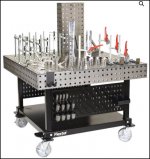Alex said:
Pretty sure the concept of holes for pegs/dogs in workbenches stems from ancient times. Plenty of pictures of old medieval benches on the net.
...
These were different. The Festool MFT holes are explicitly NOT designed to be used as peg holes.
I think what defined the first "true" MFTs (aka the 2nd iteration formed by the MFT 1080 and 800) was the specific design goal of exclusive use by power tools and the dropping of any pretense of being suitable for hand tools. This is also where the MFTs became so unstable (even compared to the FST predecessor pictured earlier). It was simply a non-issue in a pure power tool use case.
In other words, the MFTs were singularly focused on being mobile and suitable for "securing" or "placing" a workpiece for power tool operations. WIth this came below "solution" to the problem:
- the concept of a sacrificial MDF top, meaning the holes cannot be used as the (traditional) peg/dog holes, this was taken from the FST noted
- the concept of using a regular pattern of holes *across the whole table* to provide flexibility, is in, we need the holes everywhere, so why not a regular placement ?
- while at it, why not just use the 32 mm system to place the holes ? ... how about 96 mm which is close enough for flexibility and far-enough for strength ? => STANDARD #1
- while making, holes, we need to make sure folks do not try to use it with pegs (which used 22 and 25mm standards in Europe at the time) ,good, so we need smaller holes -> how about a nice round number like 20.0 mm ? => STANDARD #2
- what about the pattern, how about we make it simple, so square it is ? => STANDARD #3
The last aspect, that the holes were made on pretty accurate CNCs, caused an unintended consequence => people started using the holes as a reference for squareness and/or straightness ...
I would say what makes the MFT a Festool-first is the combination of the above properties in one product and the primary focus of the product being power tools processing of soft (aka wood) materials. Every single of the propetries, alone, was well known before. it was the combination and the execution (CNC accuracy) that created a wholly new product experience.
The best analogy would be the iPhone. It was not the first. By far. Definitely not the fastest either. Or even best in almost ANY category. But it was the first to hit the right balance of software usability and form factor in one product which made it the huge win it was.
In total, I would consider the 3 standards mentione above as what makes something a (generalized) MFT:
- hole pattern (orthogonal 96mm grid)
- hole size (20 mm)
- sacrificial nature of the work surfaces (aka it *can* be cut into, does not necessarily have to be ..)







